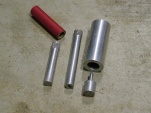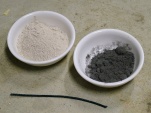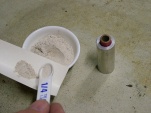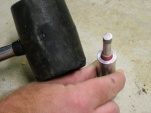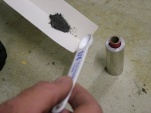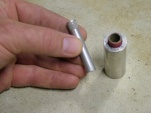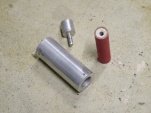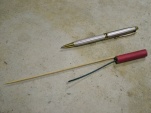Rocket (Black Powder)
From PyroGuide
There are many ways to make a rocket motor. The black powder rocket described here has been in use for many centuries, ever since black powder was invented by the Chinese approximately 1300 years ago. It is still used today since the method is quite simple and requires little tooling. As an example, we will show the construction of a 12mm rocket using standard black powder as propellant. However, the same method can be scaled up or down as required, and several other propellants may be substituted to achieve interesting effects.
Rockets are banned in many countries, for example Norway. In Norway, 40% of the fireworks related accidents was related to rockets. Handle with care!
This rocket tutorial is for an endburner style black powder rocket.
[edit] Materials
|
Casing Tools Propellant The Nozzle |
[edit] ConstructionInsert the nozzle former into the end of the aluminium sleeve. If you don't have a sleeve temporarily seal one end of the casing with a bit of paper tape. Take a small amount of nozzle mix and dump this into the casing, tapping it to settle the powder. The aim is to approximately make the nozzle the same thickness of the casings inner diameter. This can be a little tricky and is an important step in building your black powder rocket. A nozzle that is too thin will not be able to withstand the inner pressure and blow off. Make your nozzle too thick and it will affect the rockets performance. To be consistent make some tooling like a powder scoop to measure the exact amount every time that way you ware guaranteed accurate results. |
|
Insert the ram into the inner casing and gently ram it with your hammer. You don't need to use a huge amount of force to achieve a rock hard nozzle. Exerting too much force will split your casing or cause a very small fracture, which under pressure can cause your rocket to CATO. Later, we'll discuss how to fine-tune your rocket by adjusting your nozzle throat size and mandrel. |
|
Next you need to add the meal powder in small increments (as always, no more at a time than will give a layer after ramming as thick as the casings inner diameter). As with the nozzle, using a powder scoop for adding the meal powder can help produce consistent results at this point. If you add too much meal powder you can create small air pockets in the composition and this will affect the performance of your rocket. |
|
Finally, ram a layer of clay again to form an end plug. The end plug of the rocket in the example is about 10mm thick, slightly less than the casings inner diameter. If you wish to add a payload to your rocket leave one or two millimetres of the casing unfilled. This will hold the priming for the effect charge. |
|
Next you need to remove your rocket from the aluminium sleeve and carefully remove the nozzle former. If you do not have a nozzle guide and have covered the end of the rocket with paper tape then remove the paper tape from the end of the rocket and proceed to drill the hole in the nozzle. Depending on the quality of meal powder a 3 mm hole should be sufficient. Take care to centre the hole well. To increase the surface area of black powder available initially, a mandrel (core) is drilled into the propellant as well. How to fine-tune your nozzle and mandrel is discussed later. In the example, the hole was drilled 20 mm into the propellant grain. |
|
All that remains is a fuse to light and a stick to stabilise the rocket. Use a straight stick for this (see rocket stabilization below). It can be attached with hot glue or paper tape. A sufficiently long (don't economise on fuse!) length of fuse is inserted into the nozzle and core of the rocket, as far as it goes. Black match or visco fuse may be used. If the fuse is loose, to prevent it from falling out it may be secured with a small piece of tissue paper which is pressed into the nozzle opening or prime . The fuse may be bent over and held in place with paper tape on the side of the rocket. This way of fusing allows you to light the rocket without having to hold a flame directly under the nozzle of the rocket. Remember, never stand over the rocket when lighting. |
[edit] Fine tuning your rocket nozzle
The nozzle throat size and mandrel greatly affect the performance of your rocket and in small rockets this can only be found by trial and error. The quality of your black powder also has an enormous impact on nozzle and mandrel design. Some powders have a very fast burn rate creating more pressure quicker requiring a larger nozzle opening and some powders have a slower burn rate requiring a smaller opening. A deeper mandrel will also generate more thrust as this creates a larger surface area for the burn resulting in more powder being burnt at ignition time. Too deep, and the rocket will explode on the launch pad, too shallow and take-off will be very slow which will not allow the rocket to reach a proper altitude (having burnt most of its propellant even before it gains sufficient thrust to take off). So as you can see there are many factors that will affect the performance of your rocket, just keep experimenting and eventually your rocket will fly fast and high.
[edit] Rocket Stabilization
Now that you have built your rocket, it needs to be stabilized during it's flight time (in other words it needs to fly vertically). This control of your rocket is essential, not only for the safety of you or your audience but for your satisfaction. Especially if you have a payload attached, this needs to explode high in the sky and not on or near ground level. At all times we want to avoid injury or possibly starting a fire.
Stabilizing your rocket is relatively a simple process as long as you follow these rules. Your stick needs to be straight and it needs to be long and heavy enough to pass the balance test. This test is simple, attach a stick to the side of your finished rocket and try and balance your rocket on your finger. Do this by placing your finger just behind the exhaust nozzle. If the rocket topples forward, then your stick is not long or heavy enough and may cause it to fly in unpredictable directions. If it topples backwards then your stick is too long or heavy and will make your rocket sluggish and reduce it's apogee. If it's too long simply trim a small amount off and do the test again. If it's not long or heavy enough replace the stick with a larger one. Also, if you have for example 2 sticks, which both pass through the balance test, but one is longer and lighter and the other one is shorter and heavier, it's the best to pick the longer lighter stick, so that you rocket will fly better.
Basically the end result you are after is a rocket and stick that balance nicely on your finger when it is placed behind the nozzle. It's a simple process that will ensure your rocket will fly straight into the night sky and join the stars.
[edit] Video
Black Powder Rocket 1 - 451kb - Black powder rocket without payload.
Black Powder Rocket 2 - 475kb - Black powder rocket with small granite star payload.
